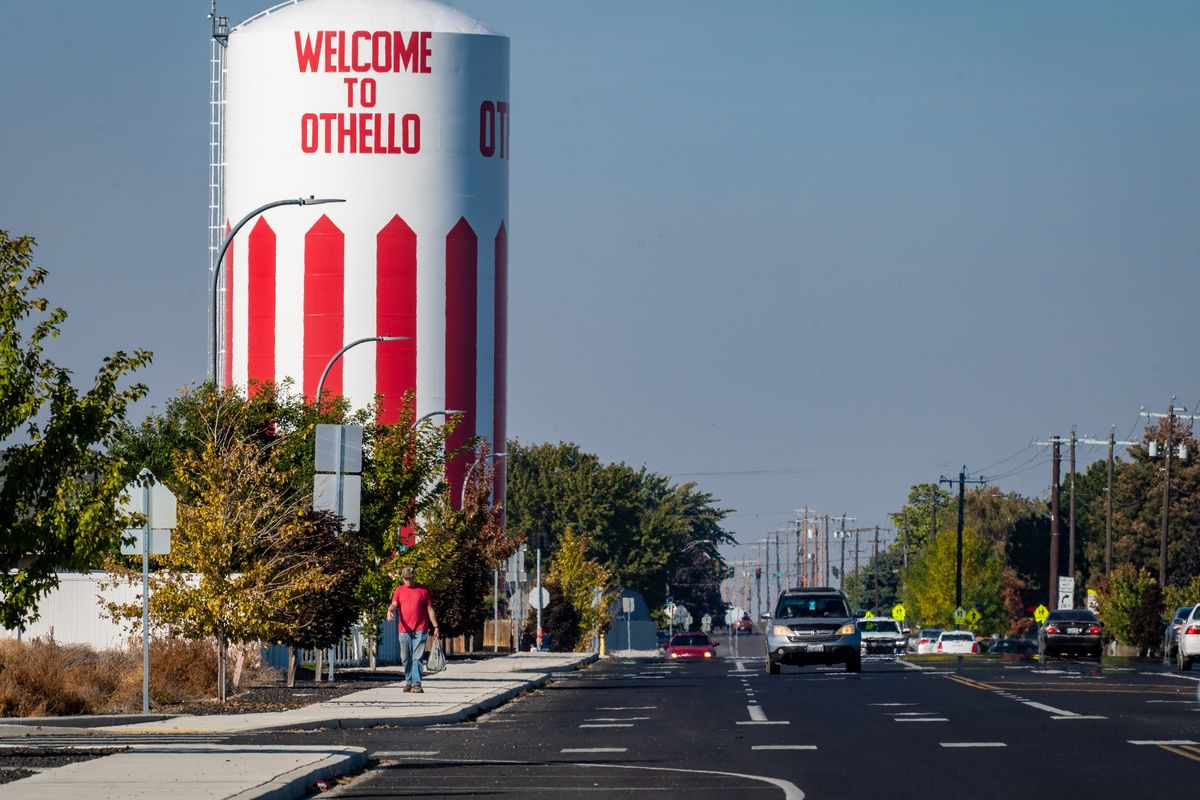Heart of the Columbia Basin: Othello is young, Hispanic and growing fast
Fueled by agriculture, the central Washington town of Othello has seen steady growth for the past 80 years. (COLIN MULVANY/THE SPOKESMAN-REVIEW)Buy a print of this photo
OTHELLO, Wash. – Columbia Basin Project irrigation transformed a little town in the panhandle of Adams County from humble beginnings as a railroad pit stop to an agricultural powerhouse that continues to grow.
Othello’s population has climbed at each U.S. Census count since 1940. When the Columbia Basin Project brought new jobs to the region in the 1950s, the population shot up fivefold – from 526 to 2,669.
And it’s still growing: The 2021 American Community Survey estimates its current population of 8,739 is up 16.1% from 2010.
The surrounding area comprising the Othello School District is nearly double that, making Othello the population center of Adams County, which has 20,613 people.
“That’s the key question everyone always asks. ‘Hey, where is everybody coming from?’ ” said Jessie ‘Weno’ Dominguez, an Othello real estate agent. “It’s a mixture of things.”
A combination of opportunity and affordability is one of them.
Surrounded on all sides by farmland, Othello is a hub for the related industries of trucking, cold storage and processing – especially potato processing.
“Othello produces approximately 50% of the nation’s frozen french fries,” Mayor Shawn Logan said.
Wages have been increasing, too. Starting jobs at Angel Garza’s construction company, for example, pay $20 to $30 an hour.
“The driver is the opportunity and availability of work here in the Columbia Basin,” said Garza, who is also a city councilman.
More people and higher wages have led to more opportunities through a greater variety of support industries. The school district and hospital have added many new jobs in recent years.
What the growth hasn’t done is price residents out of the opportunity to own a home. Othello has lower housing costs than Spokane and the nearby Tri-Cities, making it an appealing alternative.
“When the Tri-Cities’ prices started getting really high, people started giving Othello a second look,” said Dominguez, who serves on the board of the housing authority. Centrally located in the heart of the basin, Othello is within commuting distance to the Tri-Cities and Moses Lake.
Dominguez has sold homes to people from California and the West Side looking for a quieter lifestyle away from larger cities, he said.
While many small towns have a hard time retaining their youth, millennials and Generation Z who grew up there and left for college are returning because of family ties and opportunities, Logan said.
The town also trends young and Hispanic. According to the U.S. Census, 39.2% of Othello is younger than 18, compared to the statewide average of 21.7%. And 77.4% of its residents are Hispanic.
Around town, signs are in both Spanish and English, and many businesses are Hispanic-owned.
It wasn’t always this way. Gustavo Casados, 79, first came to Othello from south Texas in 1965 looking for farm work.
“Even though it was the same kind of work, the pay was better over here,” he said.
Back then, a lot of workers traveled back and forth every year for seasonal jobs. Eventually, many decided to stay, Casados said.
His nephew, Oscar Casados, 59, arrived when he was 2. Growing up in Othello, Hispanics were still in the minority, Oscar Casados said. The police officers were all white then; now most are Hispanic.
“This was a gringo town,” he said. “You had to be careful how you carried yourself, what you did.”
Things began to change in the late 1980s and ’90s as a second generation came of age and another wave of immigrants arrived from other regions of Mexico and Latin America.
Othello provided access to better education and opened the door to college for their children.
“We wanted to go to school, get educated, get a good job, because farm work – it’s not easy,” Oscar Casados said.
After high school, Oscar worked for a time in the fields before becoming a truck driver, then a commercial driver’s license instructor.
“I’m very thankful for my uncle and my grandparents for bringing us here when we were younger because we don’t have to go through what a lot of families are going through,” he said. “It’s a blessing.”
Though many have settled, there are still migrant workers. According to a 2018 estimate of farmworker housing needs, there are about 3,515 seasonal farmworker jobs in Adams County, many of them in the Othello area.
Othello is still an underserved community, Logan said. The average household income is $50,000, about $27,000 below the state average.
Yet a growing standard of living means more Hispanic families can afford starter homes, Garza said.
What’s in a name
The town was not named for Shakespeare’s tragic hero, at least not directly.
A contest was held to name the area’s first post office in 1904, said Eric Morgan, president of the Othello Museum. Homesteader Nettie B. Chavis suggested the winning name Othello after another post office called Othello in her home state Tennessee. Her prize was two city lots.
In 1907, the Chicago, Milwaukee, St. Paul, and Pacific Railroad chose the settlement for a major rail division point on the route between Chicago and Seattle. The railroad company plotted the town before it incorporated in 1910. The name Othello stuck.
Many streets reference the Bard. Hamlet Street intersects with Macbeth Avenue and Desdemona Drive while Stratford Lane loops into Hathaway Lane.
The rail company abandoned the line in 1980 after bankruptcy. Today, an original rail car sits outside the Old Hotel Art Gallery, a former hotel built for the railroad in 1912. After a 1974 murder in the hotel led to its closure and lore of being haunted, the building reopened on Halloween 1975 as a nonprofit art gallery.
Jenn Stevenson serves as the gallery’s current director and speaks fondly of her home of 17 years.
“It’s an amazing community of acceptance, support and love,” Stevenson said. “Very Christian-based. There are so many churches here, you can’t help but find one that is a good fit for you.”
Sustainable growth
Since Logan became mayor nine years ago, he has focused on growing Othello intentionally.
“One of the things that I saw was we could grow haphazardly, or we could try to create the Othello that all of us wanted,” he said.
To do that, he and the city council hired a community development director, engineers and a grant writer to help plan for the future.
The housing market has cooled to a more manageable level since spiking last year, which is “a really good thing,” Dominguez said.
“The way we were growing was unsustainable,” he said. “You just can’t grow that fast with supplies.”
While a new subdivision is expanding several blocks north of town, Othello is hemmed in by farmland with little vacant residential land left inside city limits. At the same time, there is a shortage of apartments.
Anne Henning, the community development director, said she worked with the city planning commission to work on laws that will allow for more multifamily housing in commercial zones.
“Othello has a great future,” Dominguez said. “We just need some more investments in infrastructure, I think that’s one thing that holds back our growth.”
The city also hired lobbyists to advocate for capital budget appropriations from the state Legislature, which the city has used to develop its water supply.
“When you are small community without a lot of resources,” Logan said, “you have to go to the places that do, and I think we’ve been very successful at that.”




